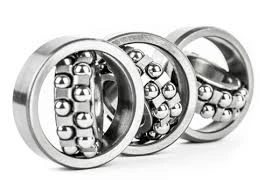
Oct . 10, 2024 23:03 Back to list
magnetic bearings theory design and application to rotating machinery
Magnetic Bearings Theory, Design, and Application to Rotating Machinery
Magnetic bearings have emerged as a pivotal technology in the field of rotating machinery, enabling substantial advancements in performance, efficiency, and reliability. Unlike conventional bearings that rely on physical contact between moving parts, magnetic bearings utilize magnetic fields to levitate and guide the rotor, effectively eliminating friction. This article explores the theory behind magnetic bearings, their design considerations, and their applications in rotating machinery.
Theory of Magnetic Bearings
The fundamental principle behind magnetic bearings is the application of electromagnetic forces to create a stable levitation environment for rotors. There are primarily two types of magnetic bearings active and passive. Active magnetic bearings use sensors and control systems to dynamically adjust the electromagnetic forces, maintaining rotor position with high precision. In contrast, passive magnetic bearings rely on permanent magnets, which naturally stabilize the rotor but may lack the precise control offered by active systems.
The design of magnetic bearings involves understanding key concepts such as magnetic flux, reluctance, and the Lorentz force. The magnetic field is generated by electromagnets or permanent magnets, which interact with the current flowing through coils. By manipulating these fields, engineers can suspend the rotor in a frictionless manner, allowing for high-speed operation and reducing wear and tear on components.
Design Considerations
Designing magnetic bearings involves several critical factors, including load capacity, stiffness, damping, and stability. The load capacity of a magnetic bearing determines its ability to support the weight of the rotor and any additional loads during operation. Engineers must ensure that the bearing can handle varying loads while maintaining stability.
Stiffness and damping are also crucial to the performance of magnetic bearings. Stiffness affects the responsiveness of the bearing to changes in rotor position, while damping helps manage vibrations that can arise during operation. Too much stiffness may lead to a rigid system that does not accommodate fluctuations well, whereas insufficient stiffness can result in instability.
magnetic bearings theory design and application to rotating machinery

Another important consideration in the design process is thermal management. Magnetic bearings generate heat during operation, primarily due to eddy currents and hysteresis losses. Adequate cooling measures must be integrated into the bearing design to dissipate heat and maintain optimal operating conditions.
Applications in Rotating Machinery
The application of magnetic bearings in rotating machinery spans various industries, notably in turbines, compressors, and electric motors. In these settings, magnetic bearings offer numerous advantages. The absence of friction not only leads to reduced wear but also minimizes energy loss, resulting in a higher overall efficiency. Moreover, magnetic bearings can facilitate high-speed operations, making them suitable for applications where traditional bearings would struggle due to heat and friction.
One significant application is in gas turbines, where magnetic bearings can help achieve higher rotational speeds and improve reliability. Traditional bearings often experience limitations at high speeds due to thermal expansion and lubrication challenges. In contrast, magnetic bearings can operate reliably under such conditions, thus enhancing the performance of turbine systems.
In the realm of industrial manufacturing, magnetic bearings are gaining popularity in precision machining and robotic systems. The precision obtained through magnetic levitation allows for tighter tolerances and improved quality of machined parts. Additionally, the reduced maintenance overhead associated with magnetic bearings makes them an attractive option in environments that require uninterrupted operation.
Conclusion
In conclusion, magnetic bearings represent a revolutionary advancement in the design and application of rotating machinery. Their unique ability to levitate rotors without physical contact offers significant benefits, including enhanced efficiency, reduced wear, and the capability to operate at high speeds. As technology continues to evolve, the adoption of magnetic bearings is likely to expand, offering solutions to some of the most challenging problems in engineering and manufacturing. The future of rotating machinery looks promising with the integration of magnetic bearing technology, paving the way for more efficient and reliable operations across various sectors.
Latest news
-
Premium Deep Groove Ball Bearings | High Speed & Reliability
NewsAug.29,2025
-
Durable Scaffolding Clamps - Secure & Reliable Tube Connectors
NewsAug.28,2025
-
Common Failures in Thrust Ball Bearings and Solutions
NewsAug.22,2025
-
How Tapered Roller Bearings Can Take Shock Loads
NewsAug.22,2025
-
Angular Bearings in High-Precision Spindles
NewsAug.22,2025
-
The Impact of Misalignment on Cylindrical Roller Bearing Performance
NewsAug.22,2025
